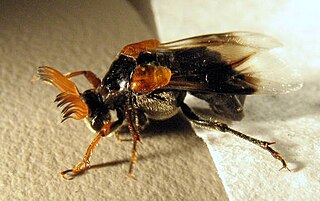
Scydmaeninae are a subfamily of small beetles, commonly called ant-like stone beetles or scydmaenines. These beetles occur worldwide, and the subfamily includes some 4,500 species in about 80 genera. Established as a family, they were reduced in status to a subfamily of Staphylinidae in 2009

Darkling beetle is the common name for members of the beetle family Tenebrionidae, comprising over 20,000 species in a cosmopolitan distribution.

The Tenebrionoidea are a very large and diverse superfamily of beetles. It generally corresponds to the Heteromera of earlier authors.

The family Oedemeridae is a cosmopolitan group of beetles commonly known as false blister beetles, though some recent authors have coined the name pollen-feeding beetles. There are some 100 genera and 1,500 species in the family, mostly associated with rotting wood as larvae, though adults are quite common on flowers. The family was erected by Pierre André Latreille in 1810.

Ripiphoridae is a cosmopolitan family of some 450 described species of beetles sometimes called "wedge-shaped beetles". Ripiphoridae are unusual among beetle families in that many species are hypermetamorphic parasitoids, an attribute that they share with the Meloidae. Members of the family differ in their choice of hosts, but most attack various species of bees or wasps, while some others attack cockroaches or beetles. Many species of Ripiphoridae have abbreviated elytra, and flabellate or pectinate antennae.

The Baltic region is home to the largest known deposit of amber, called Baltic amber or succinite. It was produced sometime during the Eocene epoch, but exactly when is controversial. It has been estimated that these forests created more than 100,000 tons of amber. Today, more than 90% of the world's amber comes from Kaliningrad Oblast of Russia. It is a major source of income for the region; the local Kaliningrad Amber Combine extracted 250 tonnes of it in 2014 and 400 tonnes in 2015.

Jacobsoniidae are a family of tiny beetles belonging to Staphylinoidea. The larvae and adults live under bark, in plant litter, fungi, bat guano and rotten wood. There are around 28 described species in three genera:
Schizopodidae is a family of beetles, in the large suborder Polyphaga. It was a subfamily until 1991, when it was elevated to family status.

Melandryidae is a family of beetles in the superfamily Tenebrionoidea. Members of the family are found worldwide, with around 420 species in 60 genera. Larvae and adults are generally associated with rotting wood and wood-decomposing fungi.

Salpingidae or narrow-waisted bark beetles is a family of beetles in the superfamily Tenebrionoidea. The species are small, about 1.5 – 7 mm in length. The family is globally distributed and consists of about 45 genera and 300 species, which are generally found in the temperate regions of both hemispheres. The family is mainly associated with plants as well as with ascomycete and hyphomycete fungi. Some members of the family are associated with unusual habitats, like Aegialites and Antarcticodomus, which are found in coastal areas including the intertidal zone, with former feeding on algae.
Psyllototus is an extinct genus of flea beetles described from the late Eocene Rovno amber of Ukraine, and from the Baltic amber of Russia and Denmark. It was named by Konstantin Nadein and Evgeny Perkovsky in 2010, and the type species is Psyllototus progenitor. In 2016, a newly described extant flea beetle genus from Bolivia, Chanealtica, was found to be most similar to Psyllototus, based on the characters available for observation.

Chelonariidae or turtle beetles is a family of beetles in the superfamily Byrrhoidea. It was described by Blanchard in 1845. There are 3 genera with around 300 described species. Little is known of their ecology, though it seems they are associated with the roots of orchids and the nests of ants and termites. Their exoskeletons are heavily sclerotised and their limbs can be effectively retracted into their bodies due to the presence of socket-like cavities. Adult specimens have seed-shaped bodies that are typically colored brown or black with lighter patches.

Abdera flexuosa is a species of false darkling beetle (Melandryidae). (Paykull, 1799)

Abdera is a genus of false darkling beetles, in the family Melandryidae. It contains three species, two of which are extinct and were discovered in 2014.
Xylolaemus sakhnovi is an extinct species of cylindrical bark beetle in the family Zopheridae. The species is solely known from the Middle Eocene Baltic amber deposits in the Baltic Sea region of Europe. The genus Xylolaemus contains a total of six extant species distributed from western Europe through the Canary Islands and North Africa to India. The species is the first in the genus to be described from a fossil specimen.

Throscidae is a family of elateroid beetles found worldwide with around 150 species in 5 extant genera. The larvae are soil-dwelling, siphoning fluid from mycorrhizae attached to trees. The adults are short-lived, with the adult males being noted for a complex mating dance. Like some other elateroids, they are capable of clicking.
2017 in paleoentomology is a list of new fossil insect taxa that were described during the year 2017, as well as other significant discoveries and events related to paleoentomology that were scheduled to occur during the year.
2015 in paleoentomology is a list of new fossil insect taxa that were described during the year 2015, as well as other significant discoveries and events related to paleoentomology that were scheduled to occur during the year.
This paleoentomology list records new fossil insect taxa that were described during the year 2014, as well as notes other significant paleoentomology discoveries and events which occurred during that year.











